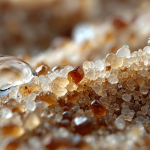Lithium (Element 3: Li)
Lithium is a soft, silvery-white metal and the lightest solid element under standard conditions. With just three protons and three electrons, it sits at the top of the alkali metal group in the periodic table. Lithium is so light that it floats on water (although it also reacts with water, so it won’t sit still for long). In its solid form, it has a density of about 0.534 g/cm³ – lower than any other metal. It is highly reactive and tarnishes quickly in air, forming a dull gray oxide coating.
The element was discovered in 1817 by Swedish chemist Johan August Arfvedson, who identified it in the mineral petalite. He was unable to isolate it in elemental form, but the discovery led to the naming of the element from the Greek word lithos, meaning “stone”. Pure lithium metal was first isolated in 1821 through electrolysis by William Brande and Humphry Davy.
Lithium has one valence electron, which it loses easily to form a Li⁺ ion. This makes it highly reactive, though somewhat less so than other alkali metals like sodium or potassium. When lithium reacts with water, it produces lithium hydroxide and hydrogen gas – sometimes generating enough heat to ignite the hydrogen. Uniquely among alkali metals, lithium also reacts directly with nitrogen to form lithium nitride.
Lithium’s small size and high charge density give it properties that are invaluable in modern technology. Most notably, lithium-ion batteries power phones, laptops, electric vehicles, and even spacecraft. Demand for the element has made it a desirable target of mining operations in Australia and elsewhere. The element is also used in heat-resistant glass and ceramics, aluminum-lithium aerospace alloys, mood-stabilizing medications like lithium carbonate (sometimes used to treat bipolar depression), and as a coolant and neutron absorber in nuclear reactors (PubChem).
Physical Data at a Glance
| Property | Value |
|---|---|
| Atomic weight | ~6.94 amu (weighted average of lithium-6 and lithium-7) (IUPAC) |
| Density (solid at 20 °C) | 0.534 g/cm³ (Royal Society of Chemistry) |
| Atomic radius (empirical) | ~152 pm (Lenntech) |
Isotopes of Lithium
Naturally occurring lithium consists of two stable isotopes:
-
Lithium-6 (⁶Li) makes up about 7.5% of natural lithium. It is useful in nuclear applications, especially for producing tritium through neutron absorption in fusion research (World Nuclear Association).
-
Lithium-7 (⁷Li) is far more abundant, making up about 92.5% of lithium found on Earth. It is commonly used in lithium-ion batteries, ceramics, and – much like its counterpart – in nuclear reactors as a neutron absorber (Wikipedia – Isotopes of Lithium).
Several short-lived radioactive isotopes of lithium also exist, but they are not found in nature and are only used in specialized physics research.
Safety Notes
Although lithium is not highly toxic, it is reactive and must be handled with care:
-
Reactivity with water: Lithium reacts with water to produce hydrogen gas, which is flammable. The reaction also generates heat, increasing the risk of ignition.
-
Chlorine gas production: The electrolysis of lithium metal from lithium chloride salts produces chlorine gas a a by-product, which is highly toxic.
-
Air sensitivity: Lithium oxidizes quickly in air and can corrode through its own reaction products if not properly stored.
-
Skin and eye hazard: Lithium metal and lithium hydroxide can cause burns on contact. Dust or powder form is especially hazardous.
-
Battery fire risk: Lithium-ion batteries can overheat and enter thermal runaway if punctured, overcharged, or exposed to fire, making safe battery design critical.
Proper handling includes storing lithium in mineral oil or inert atmosphere and using personal protective equipment in labs or industrial settings.
Further Exploration
Watch “Lithium – Periodic Table of Videos” by the University of Nottingham for a compelling demonstration of lithium’s properties, chemistry, and real-world uses, including how it behaves in air and water.


